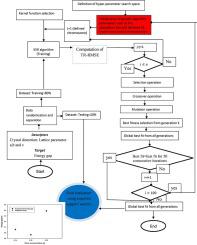Computational Materials Science ( IF 3.1 ) Pub Date : 2021-08-19 , DOI: 10.1016/j.commatsci.2021.110797 Sunday O. Olatunji 1

|
Strontium titanate semiconductor is multi-functional metallic oxide with perovskite structure and wide range of applications in oxygen gas sensors (in storage batteries), superconductivity, ferro-electricity, dielectric constant materials, dye-sensitized solar cells photo-electrodes, optoelectronics applications and photocatalysis. The wide band gap of strontium titanate metal oxide constrains its response to ultraviolent light with light harvesting capacity of 5% for incoming solar energy in generating photocatalytic activity. Anions and cations incorporation into the parent strontium titanate compound strongly break the semiconductor symmetry and ultimately influence the energy gap with stretches as well as distortions in perovskite structural architecture. This work develops genetic algorithm based support vector regression (GABSVR) hybrid model and stepwise regression algorithm (SRA) for modeling the energy gap of distorted strontium titanate semiconductor using structural lattice constants and the size of its nano-particles as model descriptors. The developed GABSVR model performs better than SRA model with performance improvement of 62.98%, 79.12% and 81.05% using coefficient of correlation (CC), mean absolute error (MAE) and root mean square error (RMAE) metrics, respectively. The developed model investigates the influence of preparation method, silver dopants, nitrogen dopants and sulfur incorporation on energy gap of strontium titanate photocatalytic activity. The developed GABSVR model was further validated externally for determining the significance of cobalt dopants on the activity of strontium titanate and the obtained energy gaps agree well with the measured values. High level of precision demonstrated by the developed hybrid model is of enormous significance for strengthening light harvesting capacity of the semiconductor for optoelectronics and photocatalysis applications.
中文翻译:

使用逐步回归和基于遗传算法的支持向量回归模拟钛酸锶多功能半导体的光能隙
钛酸锶半导体是一种具有钙钛矿结构的多功能金属氧化物,在氧气传感器(蓄电池中)、超导、铁电、介电常数材料、染料敏化太阳能电池光电极、光电子应用和光催化等方面有着广泛的应用. 钛酸锶金属氧化物的宽带隙限制了其对紫外线的响应,在产生光催化活性时,入射太阳能的光收集能力为 5%。阴离子和阳离子掺入母体钛酸锶化合物强烈破坏半导体对称性,并最终通过拉伸和钙钛矿结构的扭曲影响能隙。这项工作开发了基于遗传算法的支持向量回归 (GABSVR) 混合模型和逐步回归算法 (SRA),用于使用结构晶格常数和其纳米粒子的尺寸作为模型描述符对畸变钛酸锶半导体的能隙进行建模。开发的 GABSVR 模型的性能优于 SRA 模型,使用相关系数 (CC)、平均绝对误差 (MAE) 和均方根误差 (RMAE) 指标分别提高了 62.98%、79.12% 和 81.05% 的性能。开发的模型研究了制备方法、银掺杂剂、氮掺杂剂和硫掺入对钛酸锶光催化活性能隙的影响。开发的 GABSVR 模型在外部进一步验证,用于确定钴掺杂剂对钛酸锶活性的重要性,并且获得的能隙与测量值非常吻合。开发的混合模型所展示的高精度对于增强半导体在光电和光催化应用中的光收集能力具有重要意义。











































 京公网安备 11010802027423号
京公网安备 11010802027423号